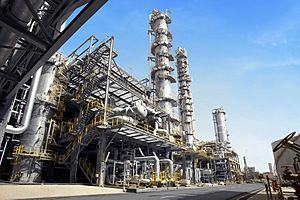Petrochemical facts for kids
Petrochemicals are special chemicals made from petroleum, which is also known as crude oil. Think of petroleum as a raw material. These chemicals can also come from other fossil fuels like coal or natural gas. Sometimes, they are even made from plants like corn, palm fruit, or sugar cane.
The two main types of petrochemicals are called olefins and aromatics. Olefins include chemicals like ethylene and propylene. Aromatics include chemicals such as benzene, toluene, and xylene. These chemicals are like building blocks. They are used to make many everyday things.
Oil refineries are places where crude oil is processed. They make olefins and aromatics by breaking down parts of petroleum. Special factories called Chemical plants also make olefins. They use a process called steam cracking on natural gas liquids like ethane and propane. Aromatics are made using a process called catalytic reforming.
Olefins and aromatics are super important. They are the starting materials for many products. These include solvents (liquids that dissolve other things), detergents (soaps), and adhesives (glues). Olefins are especially key for making polymers. Polymers are used to create plastics, resins, fibers, and elastomers (stretchy materials like rubber).
Around the world, about 115 million tonnes of ethylene and 70 million tonnes of propylene are made each year. About 70 million tonnes of aromatics are also produced. The biggest petrochemical industries used to be in the USA and Western Europe. But now, new factories are growing fast in the Middle East and Asia. Many petrochemicals are traded between different regions.
Contents
Types of Petrochemicals
Petrochemicals are grouped into three main types. This depends on their chemical structure.
Olefins: Building Blocks for Plastics
Olefins are a group of chemicals that include ethene, Propene, butenes, and butadiene.
- Ethylene and propylene are very important. They are used to make many industrial chemicals. They are also key ingredients for making different types of plastics.
- Butadiene is used to make synthetic rubber. This rubber is used in things like tires and other stretchy products.
Aromatics: For Dyes and Fibers
Aromatics are another group of petrochemicals. They include Benzene, toluene, and xylenes. Together, these are often called BTX.
- These chemicals are mostly taken from petroleum in oil refineries. They come from a process called catalytic reforming.
- Benzene is a raw material for making dyes (colors) and synthetic detergents. Benzene and toluene are also used to make special chemicals called isocyanates. These are used in making polyurethanes, which are found in foams and coatings.
- Xylenes are used by manufacturers to produce plastics and synthetic fibers. These fibers are used in clothing and other materials.
Synthesis Gas: For Fertilizers and Solvents
Synthesis gas is a special mixture. It contains carbon monoxide and hydrogen.
- This gas is used to make ammonia. Ammonia is then used to make fertilizers like urea. Fertilizers help plants grow.
- Synthesis gas is also used to make methanol. Methanol is a common solvent. It is also used to create other chemicals.
- It's important not to confuse steam crackers with steam reforming plants. Steam reforming plants are used specifically to produce hydrogen and ammonia.
Other Important Petrochemicals
Some other important petrochemicals come mainly from natural gas processing plants.
- These include Methane, ethane, propane, and butanes.
- Methanol and formaldehyde are also important. They are used in many different chemical processes and products.
Related pages
Images for kids
See also
 In Spanish: Producto petroquímico para niños
In Spanish: Producto petroquímico para niños






